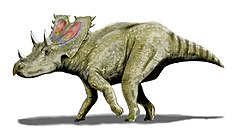Agujaceratops
Espèces de rang inférieur
- † Agujaceratops mariscalensis (Lehman, 1989)
- †Agujaceratops mavericus Lehman, Wick et Barnes, 2016
Agujaceratops (« face cornue d’Aguja ») est un genre éteint de dinosaures cératopsiens du Crétacé supérieur (formation d'Aguja) du Texas. Ce dinosaure a vécu durant le Crétacé supérieur (Campanien), il y a environ entre 77 et 70 Ma (millions d'années).
L'espèce type, Agujaceratops mariscalensis, est originellement connue sous le nom de Chasmosaurus mariscalensis (Lehman, 1989)[1]. Elle a été décrite par Lucas, Hunt et Sullivan en 2006[2] et est considérée comme la plus ancienne espèce connue de chasmosaurinés, datant d'il y a environ 77 Ma (millions d'années)[3]. Une seconde espèce, Agujaceratops mavericus, a été décrite par Lehman, Wick et Barnes en 2016[4].
Description
[modifier | modifier le code]La taille d'Agujaceratops mariscalensis est estimée à 4,3 mètres de long pour un poids de 1,5 tonne[5].
Paléobiologie
[modifier | modifier le code]Tous les échantillons d’Agujaceratops ont été recueillis dans la formation d'Aguja de l'ouest du Texas[1],[4]. Lehman a supposé qu’Agujaceratops vivait dans les marais, en raison de la nature des sédiments découverts.
Références
[modifier | modifier le code]- (en) Thomas M. Lehman, « Chasmosaurus mariscalensis, sp. nov., a new ceratopsian dinosaur from Texas », Journal of Vertebrate Paleontology, vol. 9, no 2, , p. 137 (DOI 10.1080/02724634.1989.10011749).
- (en) Spencer G. Lucas, Robert M. Sullivan et Adrian Hunt, « Re-evaluation of Pentaceratops and Chasmosaurus (Ornithischia: Ceratopsidae) in the Upper Cretaceous of the Western Interior », New Mexico Museum of Natural History and Science Bulletin, vol. 35, , p. 367–370
- (en) Scott D. Sampson, Mark A. Loewen, Andrew A. Farke, Eric M. Roberts, Catherine A. Forster, Joshua A. Smith, and Alan L. Titus, « New Horned Dinosaurs from Utah Provide Evidence for Intracontinental Dinosaur Endemism », PLoS ONE, vol. 5, no 9, , e12292 (DOI 10.1371/journal.pone.0012292)
- (en) Thomas M. Lehman, Steven L. Wick et Kenneth R. Barnes, « New specimens of horned dinosaurs from the Aguja Formation of West Texas, and a revision of Agujaceratops », Journal of Systematic Palaeontology. Online edition, , p. 1-34 (DOI 10.1080/14772019.2016.1210683).
- (en) Gregory S. Paul, The Princeton Field Guide to Dinosaurs, Princeton University Press, , p. 271.
Voir aussi
[modifier | modifier le code]Références taxinomiques
[modifier | modifier le code]- (en) Référence Paleobiology Database : Agujaceratops Lucas et al., 2006

